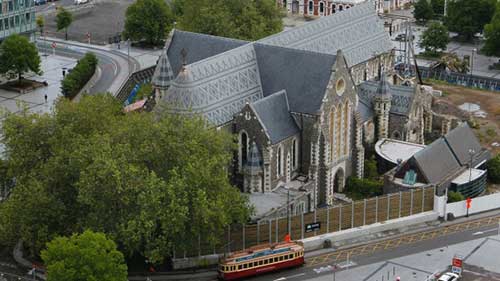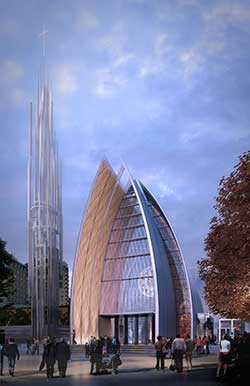
Today, at 4:30pm, many were expecting to hear the final decision about what would happen to the Christchurch Anglican cathedral in the Square, damaged in the earthquakes that destroyed so much of Christchurch. The Great Christchurch Building Trust have sought to see the building brought back essentially to as it was pre-quakes. The owners, the Church Property Trustees (CPT), were in favour of a new, contemporary building. The acrimonious controversy (which has involved the courts) was affecting the central-city rebuild, so Auckland lawyer Miriam Dean QC was appointed by the Government to broker a deal between church leaders and heritage campaigners. Today’s announcement was not the decision many expected: The Anglican Church agrees to investigate reinstating the earthquake-damaged Christ Church Cathedral.
Outward Visible Signs
If nothing else, the energy and controversy around the Christchurch cathedral building is a lesson in sacramentality – objects can be outward visible signs of an invisible reality. Objects can be multivalent, affecting people differently. We cannot say, “it is only a building”, “it is merely a cathedral”, “it is just stone and glass”.
And there is another lesson, then, as we go on to rebuild Christchurch: buildings affect our soul (whether you believe in souls or not). Our city was green and gothic. Now we have to find a newer expression. Endless rectangles of (safe-and-inexpensive) steel and glass, with straight canyons channeling the cold Easterly, cannot become the Christchurch of the future.
Post-Christendom?

NZ has two national anthems. Both are addressed to (the Christian) God. Parliament begins each day with a (Christian) prayer (the Speaker’s investigation into changing the prayer resulted in no change).
So Christchurch’s identification with the cathedral at the centre goes deep.
Creating contemporary church buildings

If we were to be restricted to something akin to that footprint, I expressed my hope there would be consideration of more “in-the-round”, flexible worship space, what came to be known as “Option 3B“. In the event, Option 3 moved from being the decided option, to a “placeholder” for some contemporary building, to now, following today’s announcement, where reinstating the building to its pre-quake look is seriously back on the table.
Blog posts on this site on church architecture.
Your comments, as usual are very welcome, and, also as usual, I will not allow ad hominem or anonymous comments. This is a website which encourages light rather than heat. If that restricts you, there are plenty of other places where you can participate on this topic without these guidelines.
If you appreciated this post, do remember to like the liturgy facebook page, use the RSS feed, and signing up for a not-very-often email, …



Sell the city the property to do as they wish and the diocese is then free to build a real cathedral that meets the Church’s 21st Century needs someplace else in town. Then the city is free to use it however they wish. But they can’t force you to worship there.
It’s pretty unfortunate when non-members get to tell the Church what it can and can’t do with it’s buildings.
And a city logo can be redesigned, or looked at as a legacy inheritance.
Yes, Br David. Some have certainly suggested that. My “Christendom” paragraph is pertinent to that discussion – the edges between “member” and “non-member” are not clean. And, furthermore, unlike other (even Anglican/Episcopal) churches, NZ Anglicanism does not have a clear definition of “membership”. It is a church in which all are welcome, and all the baptised share rights (rites). Maranatha.
“Outward visible sign” might have a more specific meaning here.. outward FRONT-VIEW sign… because many people seem to have a memory of the front view – little of the sides – and very few people are interested in the interior. I wonder how much the inside of the cathedral could be improved without any outcry that it is “different” to what they remember?
Yes, Mark. I think you are right. Or were. I think that option has now gone. My “contemporary church building” paragraph is pertinent. Rather than as you suggest, a front same/similar, an interior significantly different; the church’s design was an interior significantly similar, a front significantly different. Maranatha.
I’m not a great fan of railway-carriage seating, and I appreciate the frequently-used image for “Option 3” is merely a place-holder, but if option 3 turned out to be a lot like your Option 3B (i.e. interior changed to include circles of seats, etc…) it could still look a lot like the original design from the front. What I wonder is: would most people who love the present design come on-board and consider it to be a good compromise way to go? I don’t think anyone has found out if something like this would pour oil on troubled waters (it might be “oil on troubled fires” though?).
On the other hand, is the thinking behind those who want a “modern” design that it means something that looks from the outside to be new and exciting (to attract people), while the interior is conventional/conservative?
Thanks, Mark. Five years on from the destructive quakes, I think a lot of those ships sailed some years ago. Your point, “I don’t think anyone has found out…” was still an option some years back – I think, other than the Miles Warren design, there is no other more-than-merely-a-place-holder design that is ready to be placed alongside reinstating to engender enthusiasm. Blessings.
Interesting! I can’t begin to judge what might be appropriate for Christchurch, but I’ve been thinking about the cathedrals of the past 150 years over the past couple of days, having been dipping into Alec Clifton-Taylor’s “The Cathedrals of England”. The sense that I’m getting from that book is that contemporary styles are more successful than deliberate throwbacks to the architecture of the past, that of the ‘new builds’ Guildford and Coventry, being more adventurous, work better than Truro or Liverpool. (I’ll admit to preferring the tall, thin lines of Guildford, having lived in the diocese for six years; I think the light works better there.) I do think it might be instructive to compare Christchurch with Coventry, where something truly extraordinary was created from the ruins left after the Blitz. There’s a case for boldness.
Thanks, Kathleen. Yes, we have Guildford-like buildings here in NZ. I don’t know if you’ve worked through my architecture posts. If you have, you’ll know I’m probably more radical (more bold?) than your comment. Both Guildford and Coventry merely continue the inherited medieval pattern – not especially different to the pre-quakes Christchurch cathedral, or the contemporary design called Option 3. If you are interested in bold, I suggest looking at St. Gregory’s of Nyssa Episcopal Church – San Francisco. Not to replicate, but the principle: a church layout that starts from the contemporary theology and liturgy that it seeks to express, and then builds a building around that. Maranatha.
I have felt rather sorry for the old girl, languishing behind fences foor 4 years, exposed to the elements and inhabited by pigeons. (Given that the pigeons are pretty much the current congregation has anyone consulted them?)
Generations of prayer remain steeped in the very flagstones of the floor. The “holiness” such heritage leaves will remain on that site, regardless of the style of building that covers it.
I’m reminded of the church at Peter’s house in Capernium in Galilee. A modren building has been built on stilts over the archeological remains of the 1st century one. It is the history of the site, rather than the nature of the building, that gives it significance.
I intend to pray in the either the reinstated or the replacement building in the same way I prayed in the original.
I wonder if the pigeons pray?
I think, Claudia, that the pigeons pray better than often we do (you might get my point in a blog post I’m thinking about on prayer). Blessings.
Have just watched a video of Archbishop Rowan Williams giving a St. Paul’s (London)talk in what we might expect of the Christmas Season – using carols as a paradigm. One of his motifs related to the fact that God constantly surprises us. This is experienced in the reality that, at the Incarnation, God took flesh – not from without creation but from deeply within, thus enabling a ‘new-creation’ to take form.
I think this is what is needed in our Cathedral in the Square – something new and exciting, from within but utterly transforming the structures, so as to be almost unrecognisable from the past reality. (Spires tend to topple easily!)
This might best be – as Archbishop Rowan suggests – arrived at by letting go of the past, and being open to accepting what might be transformed from it – into a future more glorious and tenable. Just like the humanity of Jesus has transformed our common human nature – from the ruins of its past, into the beauty of a ‘new creation’..
I reckon we need a fresh start, using the materials, shape and form, that will best deliver what we require from a worship structure; that is safe, affordable and economically viable – NOW.